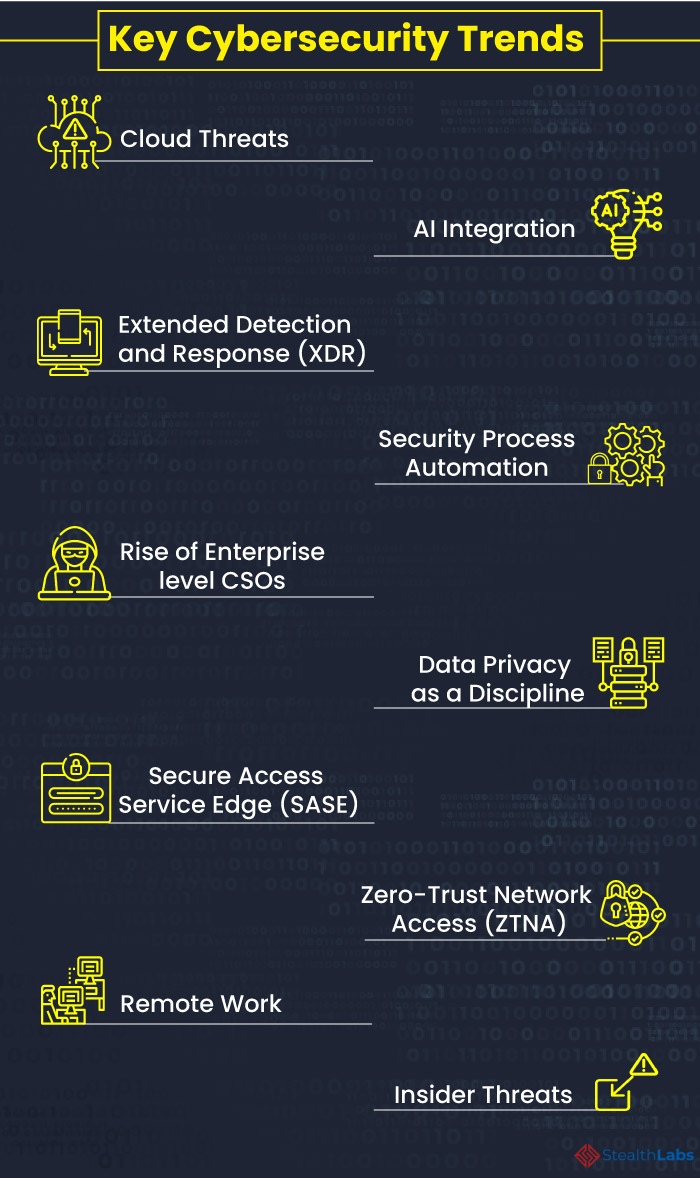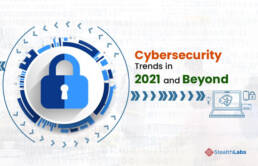Technology is evolving rapidly and changing the way businesses operate.
Emerging technologies such as cloud computing, Artificial Intelligence (AI), automation, and the Internet of Things (IoT) are creating unprecedented opportunities for businesses to unlock new value.
However, this value is not assured. As technology evolves, so does the cyber threat landscape that organizations must navigate. In fact, it is estimated that the cyber threat globally slows the pace of technology innovation by as much as USD 3 trillion in lost economic value in 2020.
The shortage of skilled security personnel, complex compliance requirements, the evolution of cyberattacks, and insider threats continue to be the most prominent ongoing cybersecurity challenges.
However, navigating the coronavirus pandemic remains the biggest challenge for global security organizations in 2020. It is no surprise that data breaches have grown in volume and complexity in 2020, with the number of breaches increasing 273% in the first quarter, compared to 2019. What’s even more shocking is that only one hacker has stolen 34 million user records from seventeen companies in 2020.
As companies look to transition to a new normal in 2021 and beyond, here are some key cybersecurity trends:
Key Cybersecurity Trends in 2022 and Beyond

1) Cloud Threats
As remote work and online collaboration intensified during the coronavirus pandemic, cloud adoption has emerged as an ally for enterprises to ensure business continuity. Though global businesses have been migrating to the cloud before the crisis, the pandemic acted as a catalyst for the same.
According to IDC, the global cloud services market spending is projected to reach USD 1 trillion in 2024, at a CAGR of 15.7% during the forecast period 2020-24.
However, rapid cloud migration is set to introduce a host of new security threats and challenges.
Cloud-based security threats, including misconfigured cloud storage, reduced visibility and control, incomplete data deletion, and vulnerable cloud apps, will continue to disrupt businesses in the future ahead.
2) AI Integration
As cyberattacks continue to grow in intensity and frequency, Artificial Intelligence (AI) helps under-resourced security teams to stay ahead of the threats.
By analyzing massive quantities of risk data from structured and unstructured resources, AI provides threat intelligence quickly for the security team to remediate the threat.
According to market estimates, artificial intelligence in the cybersecurity market is projected to grow from USD 8.8 billion in 2019 to USD 38.2 billion by 2026 at a CAGR of 23.3%.
3) Extended Detection and Response (XDR)
With growing data breaches, the security teams are pressed to gain visibility of all data across emails, endpoints, networks, servers, cloud workloads, and applications.
The Extended Detection and Response (XDR) will be more popular as they can automatically collect data from multiple endpoints and correlate them to quickly detect and respond to threats.
For instance, a cyber incident that caused alerts on a server, network, and application can be combined and correlated to enable visibility and context into the incident.
4) Security Process Automation
According to Cybersecurity Ventures, the cybersecurity talent crunch is expected to create 3.5 million unfilled cybersecurity jobs by 2021, up by 350% from 1 million positions in 2014.
The lack of experienced security staff will make organizations to rely on security process automation. Security automation tools eliminate repetitive security operations by automating them based on pre-established rules and procedures. Thus, the security tasks can be performed quickly, effectively, and with fewer errors.
5) Rise of Enterprise-level CSOs
In recent years, cybersecurity incidents, threats, and vulnerabilities beyond traditional enterprise IT systems skyrocketed, pushing organizations to reinforce their security level.
Cyber incidents such as siegeware attacks on infrastructure management systems, increasing OT/OT system vulnerabilities, and GPS spoofing attacks continue to challenge the cyber-physical world. Thus, businesses that relied on the IT security-centric approach proved incapable of dealing with the effect of security risks on physical safety.
Therefore, organizations that implement cyber-physical systems are set to deploy enterprise-level Chief Security Officers (CSOs) to collaborate with multiple security-oriented silos.
The CSO can bring physical security, IT security, OT security, product management security, and supply chain security into a centralized governance model.
6) Data Privacy as a Discipline
With the growing concerns regarding data management and security, data privacy, from being a part of compliance requirements, will become an increasingly significant, stated discipline of its own.
As a standalone discipline, data privacy impact almost all aspects of an organization, from co-directing the corporate strategy to closely aligning with security, HR, governance, and procurement.
7) Secure Access Service Edge (SASE)
The coronavirus pandemic has triggered growing remote working culture, cloud adoption, and online collaboration.
Thus, organizations’ network security is transforming from LAN-based appliance models to cloud-native security service models, including Secure Access Service Edge (SASE).
SASE technology enables organizations to robustly secure remote workforce and cloud applications by routing the network traffic through a cloud-based security stack.
According to Gartner, around 40% of businesses will adopt explicit strategies for implementing SASE by 2024, from <1% in 2018.
8) Zero-Trust Network Access (ZTNA)
Earlier, IT departments relied on Virtual Private Networks (VPNs) to facilitate access to the corporate network for the remote workforce. As COVID-19 pushed almost all employees to remote working, VPNs proved woefully inadequate.
Zero-Trust Network Access (ZTNA) has emerged as a more secure option for organizations to control remote access to specific applications.
“ZTNA is a technology that provides controlled access to resources, reducing the surface area for attack. The isolation afforded by ZTNA improves connectivity, removing the need to directly expose applications to the internet.” – Gartner
According to Gartner, 80% of new digital business applications will be accessed through ZTNA by 2020, and 60% of enterprises will move from remote-access VPNs to ZTNA by 2023.
9) Remote Work
Amid the pandemic, remote working has drastically changed the way global businesses operate, and the trend shows no signs of slowing down.
According to Gartner, 88% of global business organizations mandated or encouraged all their employees to work from home due to the pandemic.
Though the move to remote working was fast and furious for a lot of organizations, it is the future of work.
However, organizations must implement the right tools to ensure that remote access is secure, and endpoints used by employees are patched effectively.
10) Insider Threats
Remote work has left global organizations unprepared to monitor or identify insider threats due to unauthorized remote access, weak passwords, unsecured networks, and the misuse of personal devices. These patterns will spike in 2021 and beyond.
According to Forrester, insider data breaches will increase by 8% in 2021 and account for 33% of all cybersecurity incidents.
In Conclusion

As cybersecurity trends keep emerging, organizations must adopt a proactive IT security posture, rather than reactive, to keep business secure. They must become more nimble, more flexible, and more collaborative as they strive to secure their critical assets.
However, the far-reaching tentacles of cyber and evolving threats will make it hard for organizations to effectively focus on their core business objectives while ensuring security. Turn to Managed Network Security Services like StealthLabs to prevent, detect, and respond to evolving threats.
Cybersecurity Trends and Beyond – Faq’s
Due to increased cyber security incidents, we can expect a rise in security spending. Additionally, AI will be roped in to swat away threats as they arise.
As the security needs will burgeon, automation will be ingrained at a faster pace than before. These are just some of the significant trends which shall arise on the cybersecurity front.
Cybersecurity breaches are unwelcome, and they set you back on various fronts. From data to business information, you would lose your business momentum. It is important to land in such a soup by roping in a cybersecurity firm, such as StealthLabs , to bolster your security posture.
More Articles:
- All Data Breaches in 2020
- What Measures Should You Adopt for Managing Insider Threats?
- How Businesses Can Implement ‘Zero Trust Security’?
- 83% Of Large-scale Enterprises Transformed Their Cybersecurity Due To Pandemic!
- Hacker Steals 34 Million User Records from 17 Companies
- Top Cyber Threat Facts, Figures, and Statistics

